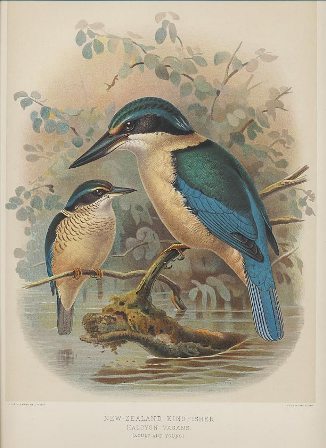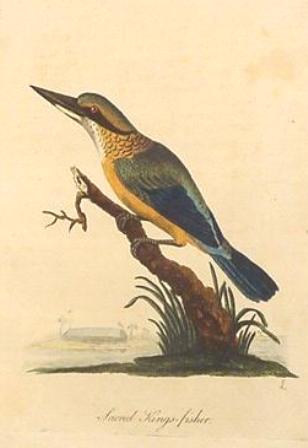
Kotare, the kingfisher, is around here in numbers again and it is good to hear their friendly piping as well as their harsh alarm rattle. They seem to have had a good breeding season as many are juveniles, being brownish in colour, unlike the brilliant blue and green of the adults. They had virtually disappeared from around here over the last few years, I think largely because of the carelessness of local council workers who came along the road to cut back about a foot off the cuttings just at the wrong time of the year. It was late in November and the nesting sites, together with the young birds, were destroyed. It was sad to see the parents afterwards, frantically trying to make new nesting holes, literally throwing themselves against the banks. It was not a good year for them.
I am a bit surprised to see so many of them around here at this time of year as I was under the impression that during the autumn and winter months they headed for the coast, to the mud flats where food in the form of crabs is abundant. I had thought that they just came up the valley for the breeding season, to find good nesting sites, but perhaps it is a little early yet, or still too warm, for them to leave for the coast.
The species Halcyon sanctus is found in New Guinea, Australia, Tasmania, New Caledonia, the Solomon, Kermadec, Lord Howe, Norfolk and Loyalty Islands. The New Zealand sub-species, vagans, is distinguished from the Australian sub-species by its larger size and broader bill and generally by the distinctiveness of its green and blue colours.
Halcyon is the Greek word for kingfisher and refers to a bird fabled to breed about the time of the winter solstice in a nest floating on the sea and to charm the wind and waves so that the sea was then specially calm, hence halcyon days. The specific name of sanctus, the Sacred Kingfisher, was, according to the ornithologist W.H. Oliver, bestowed on the species as far back as 1782 because of the veneration paid to the bird in some Pacific Islands.
Kotare is distinguished by its habit of perching in a prominent place and waiting for its prey to appear. The collective noun of “a concentration of kingfishers”, would seem to be entirely appropriate. The bird is all head and shoulders with a very broad bill, made, it would seem, for driving into clay banks or a tree to make nesting holes.
According to Oliver, it is a fearless bird and readily attacks mammals and birds of its own size and larger. “Starlings are driven away, red billed gulls put to flight, a Tui killed, cats and dogs blinded in one eye and even weasels attacked. Every kind of small animal is attacked, killed and eaten by the kingfisher. The mouse is a first favorite and the bird’s sharp eyes and quick actions are usually effective when one comes into view. Before being swallowed the victim is pulped and its bones broken by battering on the kingfisher’s perch. Small birds such as Tauhou, the white eye, are eaten and lizards where they are plentiful. Larger insects also form part of the diet.“
Fish form only a small part of their diet but whitebait are taken in the lower reaches of the rivers in spring and goldfish in ponds are not safe. They have been photographed diving into the water after prey with their wings clapped to their sides like a gannet.
However, around here, I have mostly observed them taking nothing more than worms and insects so I must take their bad reputation on trust.
They nest in a burrow either in a clay bank or a tree, very often a decaying willow. As described by many writers and observers, to start a tunnel they sit an a branch slightly above and several metres away from the site and fly straight at it, neck outstretched and uttering a peculiar whirring call, and strike it forcedly with the bill tip. They continue until the hole is big enough to perch in and scoop out. The nesting burrow can be as much as 24cm long and will be used year after year.
The female does most of the brooding while the male supplies the food. They are bad housekeepers and the nests are often quite filthy.
Elsdon Best has expressed some surprise that Maori never used the feathers of Kotare for decorative cloaks, considering the bird’s very colourful feathers. “The young of this bird were taken from the nest in former times for the pot, or rather steam pit”, he has written. “Some Maori, however, were prejudiced against them because it was observed that they ate lizards which are regarded as guardians of the mauri of the forest.” They are not, it seems venerated by Maori.

Other common names: —
Sacred kingfisher, New Zealand kingfisher.
Description: —
Native bird
24 cm., 65 g., green fading to blue on the head and upperparts, buff underparts and collar.
Where to find: —
Widespread and common.
Youtube video —
Poetry: —
He peo koe, he pitoto koe,
He pinino koe, he piro noa -
He kotare koe!
You come quickly, you sit begging, you keep asking for it, you won't go away - You're a kingfisher.
— Margaret Orbell, The Natural World of the Maori, 1985.
Why do you sit, so dreamily, dreamily,
Kingfisher over the stream,
Silent your beak, and silent the water,
What is your dream?
A falling, a flash of blue and silver,
Child, he is deep in the stream,
Prey in his beak, and fear in the water -
That was his dream!
— Eileen Duggan
Illustration description: —
Buller, Walter Lawry, Birds of New Zealand, 1888.
Latham, John, A General Synopsis of Birds published London, 1795.
Reference(s): —
Heather, B., & Robertson, H., Field Guide to the Birds of New Zealand, 2000.
Oliver, W.R.B. New Zealand Birds, 1955.
Page date & version: —
Monday, 26 May 2014; ver2009v1

